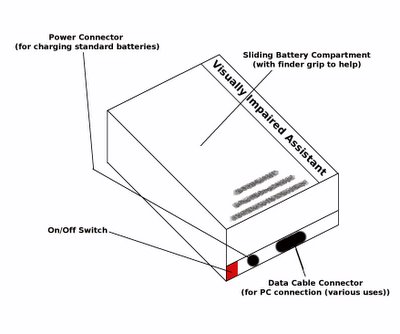There is one thing we haven't talked about so far which is absolutely important - device pairing.
Many devices will pair with our system via the Brain. Devices that will almost always be paired with the Brain are the Smart Watch and the Smart Headphone, other than these there will be many possible devices that can be paired with the brain. The most obvious of which will be the supermarket scanner.
So what does all this mean? Well first off, both the Smart Watch and Smart Headphone are wireless devices and this means they need to communicate wirelessly with the Brain. The most obvious and simplest way to do this is with the simple
Radio Frequencies (RF) over a short distance, however, if we used standard RF like that found on a analogue house phone we quickly run into difficulties due to
RF interference and also issues where devices using the same frequencies/channels could or would cause problems and unprotected transmissions and no authentication/encryption on the system could allow intruders in to the system in order for them to satisfy their hunger for malice. Therefore a few features for the wireless communication system are essential:
*It must not interfere with other objects/devices
*It must have a unique identification system so that devices of the exact same type in close proximity used by other users do not interfere with one another (e.g. your Smart Watch doesn't start giving instructions to your friends Brain)
*All transmissions must be encrypted with device ID as part of the authentication process so that the system knows the message came from an already authenticated paired device (and not some hacker) and the encryption stops messages being obtainable by the wrong hands.
Two other important features of the pairing system is that the wireless communication needs to be of low power consumption and of rather low radius around the user (on average between 1 and 3 metres) and of course the communication channel must be able to effectively and efficiently handle all communications.
To achieve all of this, enter
Personal Area Networks (PAN) and more specifically,
Bluetooth.
Bluetooth has all the features we need to achieve our pairing and wireless communication ideas, I shall explain all the bits that are useful to us here and I will then finish with what alterations we would need to have on a standard Bluetooth system to suit our needs.
The first useful part of Bluetooth for us is its power consumption and range, being a PAN technology it is meant to be used in small radiuses and also to consume little power and Bluetooth achieves exactly this, a 1 metre radius can be recognised with just over a milliwatt of power consumption and 2.5 milliwatts roughly produces a 10 metre signal radius, which more than covers our needs.
As of Bluetooth version 1.2 there has been Adaptive Frequency-hopping spread spectrum (AFH), this can be used to prohibit two devices of the same type interfering with one another (as mentioned above). More information on this can be found
hereFor security, Bluetooth uses the
SAFER+ algorithm, this more than covers our needs.
Of course, on top of all this, Bluetooth allows device
pairing, one of the most important features of our wireless communication system. However there would need to be differences between our 'Bluetooth' pairing and that of the current standard Bluetooth, as detailed below:
Our system would need to be able to work without the need of a passkey, this means that the only device which can have more than one slave is the Brain, all other devices which work with the Brain will have a maximum of one slave and to go along with this, slave devices will not be allowed to request or try to force pairing with the master (the Brain), only the Brain can make such requests of slave devices. To go with this, the encryption process needs to be changed to reflect how this part of our system works.
Further, there needs to be more than 6 possible slave devices as we cannot guarantee that 6 slave slots are enough.
Finally there needs to be a two tier device pairing system and this needs to be similar to DHCP server software such that the master has a 2 tier list device, one that has never expiring entries for devices such as the Smart Watch and Smart Headphone. Should these devices ever get replaced, pairing the newer devices with the Brain replaces the older devices in this section of the list. The second tier of the list needs to have fields that can expire, typically after 30 minutes. This is to allow for devices such as barcode scanners that are owned by the supermarket and not the user to be automatically de-paired from the Brain after the user has finished shopping, just in case the user forgets to do so.
If I think of anything more that the pairing needs to do, I'll make a second post as this one is already a mile long!



